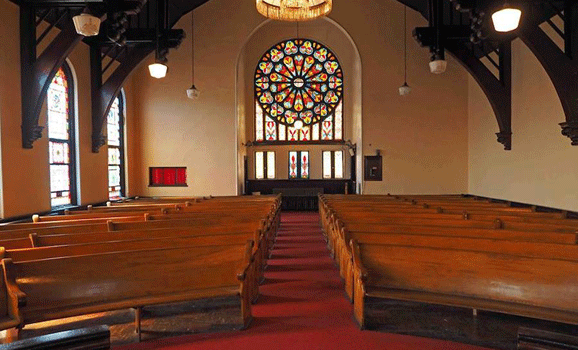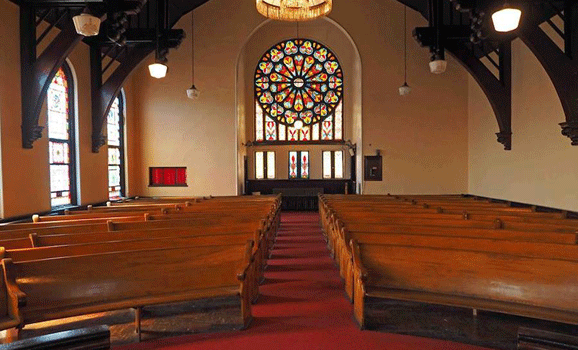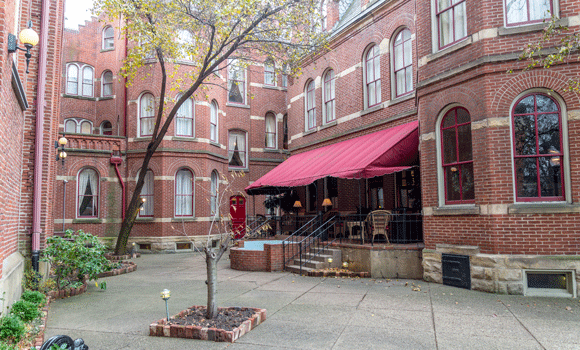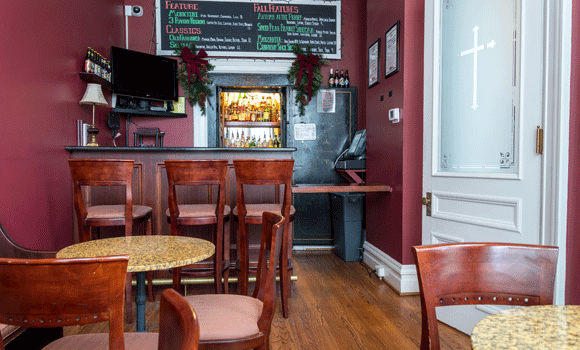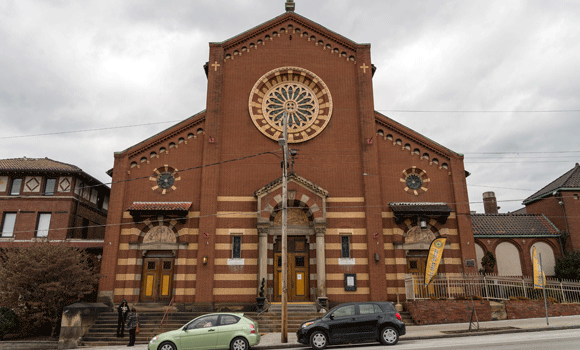As with many Pittsburgh churches before, Immanuel Methodist Church on the North Side is about to see a new type of congregation. Instead of setting sanctuary for a religious flock, the closed church building and two neighboring properties are being transformed into an arts center: The Neu Kirche Contemporary Art Center, slated to open in September 2015.
The name Neu Kirche is German for “new church” and is a nod to the building’s German architecture and the site’s Deutschtown roots. The nonprofit center will offer studio and performance space, while working to create and advance contemporary art in Pittsburgh. According to Lee Parker, who owns the building and runs the nonprofit with her husband Greg Parker, they plan on supporting local creatives and bringing in international artists.
“We were looking for a building that had architectural merit,” recalls Lee, “that was perhaps historic and that was in an area that needed assistance … We believe in creative placemaking.”
The couple were drawn to the Spring Garden community because of infrastructure changes — like the installation of Interstate 279 — that have separated the neighborhood from the rest of the North Side.
Lee says she wants to “engage in a real way with the community… We want our center to operate as a meeting [space] for the community.”
The repurposing of Immanuel Methodist is just one more example of the transformation of neighborhood churches in Pittsburgh. What emerged as an urban trend 20 years ago is becoming a noted tradition in the region.
European immigrants who settled in Pittsburgh in the early 20th century built architecturally significant chapels. After the collapse of the region’s steel industry, the population dwindled, resulting in shrinking congregations and church closures.
Earlier this year, the Roman Catholic Diocese of Pittsburgh announced that Holy Cross Parish in East Pittsburgh would merge into Good Shepherd Parish in Braddock. At that time, the two church buildings in use by Holy Cross Parish, Saint Helen and Saint William, closed. In 2012, the Holy Cross Parish had one baptism and 19 funerals, and the trend was unlikely to reverse, according to the diocese. The general population of the territories of Holy Cross and Good Shepherd has declined 21 percent since the 2000 census.
According to the diocese’s website, more than 130 church properties have been sold since 2003, and 158 parishes have dissolved since 1990. And many of these parishes, with approval from the Diocese, have gone on to second lives as residential properties, breweries and more.
“There’s obviously a need to protect… a building that was once sacred,” explains Diocese Chief Facilities Officer Michael Arnold about limitations placed on church properties during a sale. “We also go in and remove religious iconography prior to the sale.”
According to Arnold, items that are removed depend on what the renovation entails, but pews and stained glass are often decommissioned.
While some may wonder why the Diocese would go along with a secular refurbishing of church property, one must realize that, like any abandoned site, an empty church comes with responsibilities including maintenance costs, liability and blight.
A closed church remains the property of the parish and it is up to the parish to determine the fate of the building, explained John Flaherty, secretary for parish life at the Diocese of Pittsburgh, in an April interview discussing the closure of the three churches.
“They can mothball the building against some future use, demolish the building, lease it, sell it or reuse it for some other parish need,” he explained. “The diocesan bishop would have to approve any lease, sale or demolition of the former church building.”
Depending on lot size and location, church properties can go on the market with asking prices ranging from $50,000 to $2.5 million.
On Troy Hill, the former North Catholic High School and its nearly 5-acre campus is listed for $2.5 million, according to the Howard Hanna website. Also listed by Howard Hanna is the Mt. Lebanon Baptist Church in Dormont at $1.2 million.
A mere five miles away from Mt. Lebanon Baptist Church, the former Saint Henry Church and rectory house on Arlington Avenue in Arlington Heights is listed for sale at $50,000, while the former Bishop Leonard Catholic School in Mt. Oliver is listed at $30,000, according to diocesan documents from earlier this year.
There are also religious properties listed in Homestead and Carnegie at $159,900 and $365,000, respectively.
When God Closes a Door …He Opens a Hotel? Brewery? Restaurant?
Less than half a mile away from the new Neu Kirche sits one of Pittsburgh’s first church rehabs, The Priory Hotel. The hotel opened in 1988 after the property was nearly demolished to build Interstate 279. The congregants of another church down the street fought the demolition and the Department of Transportation rerouted the road. At that point, Ed and Mary Ann Graf purchased the shuttered Benedictine priory and church, renovating the monastery into a hotel.
St. Mary’s Church, as it was known during its Deutschtown days, was built in 1852, and St. Mary’s priory in 1888. The Grafs repurposed the church building in the 1990s as the Grand Hall.
“It still very much resembles a church,” insists John Graf, son of Ed and Mary Ann and Priory Hospitality Group president and CEO. He noted that the hall still has original stained glass, fixtures, beams, art and scroll work. “When you come in, you can tell you’re in something that’s been a church before. We try to honor that history.”
The hotel is also home to the pint-sized 14-seat Monks’ Bar, a nod to the site’s erstwhile Benedictine residents.
An expert in church reuse
Across the Allegheny River and a few miles east, The Church Brew Works has become an icon on Liberty Avenue. In 1996, owner Sean Casey paid $191,200 for the building.
Casey also purchased St. Kieran’s in Lawrenceville last year, which will be converted into residential property — making Casey a double veteran in church renovation.
“They’re really cool. They’re beautiful,” he says. “And, in a sense, they’re great intriguing buildings for adaptive reuse.”
And by working with different parochial buildings for 18 years, Casey has become a resource for business owners restoring churches across the United States. He warns entrepreneurs to first and foremost protect the buildings from further damage: Splurge in the beginning on a new roof and fix all the leaks.
Next, Casey suggests owners find their passion, because a church space can be transformed into almost anything from art and music studios to restaurants to housing. Pittsburgh has seen all such uses.
And when the churches aren’t updated, they’re “pancaked,” says Casey. “They’re architectural treasures in the city that are worth saving.”
The Church Brew Works is rich with artifacts and architecture from the space’s history as St. John the Baptist. Details like hand-painted cypress beams on the high vaulted ceilings, intricate glass windows and the iconic blue apse were preserved. Mini pews were constructed from the church’s original benches for guest seating, and the excess oak from shortening the pews was used to build the bar. The altar now houses the brewery’s steel and copper tanks.
A Tour of Pittsburgh’s Renovated Churches
In addition to the Brew Works, other churches-turned-taprooms are scattered around town, starting with Mr. Small’s Funhouse, formerly Saint Ann (1924 to 1998). The Millvale venue, owned by Liz Berlin of the band Rusted Root and her husband Mike Speranzo, has seen a myriad of impressive acts from Muse to Fallout Boy to Broken Social Scene since it opened in 2003. Its repairs notoriously include slanted, outdoor balconies. Berlin and Speranzo also own the United Methodist building across the street from Mr. Small’s which is being transformed into the Creative Life Support Center, a site for the non-profit part of Small’s, a recording studio, cafe and musical instrument store.
Charlie Murdoch’s Dueling Piano Bar, a former Ukrainian church on the South Side, prides itself on being a “Famous Rock & Roll Church.” And Oakland’s Sphinx Café offers a hookah bar with Middle Eastern ambiance in a converted church.
The Altar Bar has embraced the church vibe in a different way — the former St. Elizabeth Church in the Strip District has a tongue-in-cheek approach to its history, which is seen in its name (with a crucifix for a “t”) and on its website, which states, “The Altar Bar is a premier music venue hell-bent on resurrecting live music in the city.”
In Brookline, Overbrook Presbyterian lives on as The Church Recording Studio. Owner Dana Cannone described the studio as an optimal recording space in a 2013 Pop City Media interview. He said churches are designed to create great acoustics. Further west in the South Hills, Cefalo’s Banquet & Event Center in Carnegie opened in 2005 at the site of the former Christ United Presbyterian Church.
Some churches have adhered closer to their original missions, becoming community spaces. Bloomfield-Garfield Corporation’s community center, located on North Pacific Avenue in Garfield, is a former Methodist church constructed in 1898. The Union Project on N. Negley Avenue was once Union Baptist Church. Today, it serves as a community center, event venue and creative space.
The Nyia Page Community Center in Braddock also has a holy history as First Presbyterian. A decade ago, the Nyia Page Community Center was slated for demolition. Today, the building, run by the nonprofit Braddock Redux, is home to a host of after-school activities and children’s programs. In 2012, the facility added the Braddock Community Cafe — which has a goal of providing healthy food options in Braddock.
